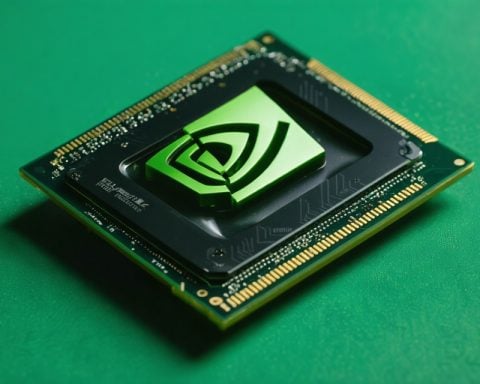- Microsoft unveils a potential scientific breakthrough with the introduction of Majorana 1, a quantum processor based on topological superconductivity.
- Majorana 1 is designed to handle a million topological qubits, using an advanced structure similar to semiconductor transistors.
- The processor’s development signifies a pivotal moment in quantum computing, moving it closer to practical and commercial applications.
- Despite the potential impact, market reaction to the announcement is cautious, reflected by a minor 1% rise in Microsoft shares.
- The technology challenges existing computing paradigms and heralds a shift towards quantum supremacy.
- The development marks a significant step in the journey from theoretical physics to real-world computing solutions.
- The broader question remains about society’s readiness for the transformative quantum revolution.
Microsoft makes waves with a groundbreaking revelation, introducing a tantalizing prospect for the future of computing. The tech behemoth hinted at a scientific breakthrough, unveiling a state of matter previously confined to the realms of theoretical physics—topological superconductivity. This scientific milestone serves as the foundation for Microsoft’s latest innovation, a quantum processor named Majorana 1.
Forged in the crucible of quantum research, Majorana 1 doesn’t merely challenge conventional computing; it promises to redefine it. This remarkable processor boasts the capability to wrangle a million topological qubits, utilizing its avant-garde structure akin to traditional semiconductor transistors. Yet, the stakes are astronomically higher. Picture this: a semiconductor nanowire, brought to life under precisely orchestrated conditions, metamorphosing into a conduit of superconductivity—magic realized through science.
While the blog post from Microsoft’s quantum computing leadership ignites curiosity, the market reaction remains tepid, with Microsoft shares inching just 1% higher. This muted response belies the potential seismic shift that such a development could herald. Quantum computing, once a speculative venture nestled in the confines of physics textbooks, now inches tantalizingly closer to commercial viability.
As Microsoft nudges the boundaries of what’s possible, the lingering question emerges: are we ready for a quantum revolution? With Majorana 1, the vision of ultra-powerful computing inches closer to reality, promising breakthroughs that were, until recently, the stuff of science fiction. The march toward quantum supremacy accelerates, as Microsoft and others advance the dawn of a new computational era.
Unlocking the Quantum Frontier: How Microsoft’s Majorana 1 Might Change Everything
How-To Steps & Life Hacks: Embracing Quantum Computing
While the Majorana 1 processor might be beyond the reach of individual users, businesses and tech enthusiasts should prepare by:
1. Learning Quantum Fundamentals: Understanding the basics of quantum mechanics and computing can be valuable. Platforms like IBM provide educational resources about quantum computing.
2. Staying Informed: Follow developments from companies like Microsoft, Google, and IBM to stay up-to-date with quantum advancements.
3. Exploring Quantum Software: Familiarize yourself with quantum development kits like Microsoft’s QDK or IBM’s Qiskit to get hands-on experience.
Real-World Use Cases: Potential Applications
Quantum computing promises breakthroughs across various sectors, such as:
– Healthcare: Enabling better drug discovery processes.
– Finance: Offering unprecedented optimization models for high-frequency trading.
– Cybersecurity: Creating unbreakable encryption methods due to quantum key distribution.
– Supply Chain Management: Optimizing logistical routes and reducing delivery times.
Market Forecasts & Industry Trends
– Growth Projections: The quantum computing market is anticipated to grow significantly, with estimates suggesting it could reach $65 billion by 2030.
– Industrial Adoption: While currently in a nascent stage, industries such as finance and pharmaceuticals are early adopters due to the potential for significant benefits.
Reviews & Comparisons: Microsoft vs. Rivals
– Google: Google’s Sycamore processor has achieved quantum supremacy, but Microsoft’s focus on topological qubits sets it apart with potentially more stable quantum systems.
– IBM: IBM’s development of superconducting qubits competes with Majorana 1, yet the topological approach might offer more scalable solutions.
Controversies & Limitations
– Technical Challenges: Quantum error rates, decoherence, and the high cost of research are significant hurdles that firms face.
– Ethical Concerns: There are debates about the societal impacts and ethical use of quantum capabilities, especially concerning cybersecurity.
Features, Specs & Pricing
While exact specs of Majorana 1 are not publicly available, its promise lies in utilizing a million topological qubits, which surpasses the capabilities of many existing quantum systems.
Security & Sustainability
– Quantum Security: Majorana 1 could advance quantum-resistant encryption, crucial for future-proofing cybersecurity.
– Sustainability: The superconductive nature of Majorana particles entails lower energy consumption compared to classical systems.
Insights & Predictions
– Expert Opinions: Experts believe that topological qubits offer a more stable path to scalable quantum systems, potentially accelerating the timetable for achieving quantum supremacy.
Tutorials & Compatibility
– Tutorial Access: Leveraging resources from Microsoft and other open-source platforms can provide tutorials on programming for quantum systems.
Pros & Cons Overview
– Pros: Offers unparalleled computing power, faster problem-solving capabilities, advancement in several critical sectors.
– Cons: High development and operational costs, limited by current technological maturity, ethical questions regarding its deployment.
Actionable Recommendations
1. Educational Investment: Start with online courses on quantum computing to familiarize yourself with the basics.
2. Networking: Join forums and communities like Stack Exchange to engage with experts and enthusiasts in quantum computing.
3. Experimentation: Use available quantum computing simulators and development kits to build a foundational understanding of quantum programming ready for industrial application.
Prepare for the quantum era by adopting a proactive learning stance—what seems like science fiction today could soon become our computing reality.



















